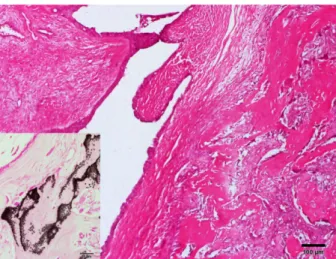pISSN 2466-1384 eISSN 2466-1392 大韓獸醫學會誌 (2016) 第 56 卷 第 4 號 Korean J Vet Res(2016) 56(4) : 229~232 https://doi.org/10.14405/kjvr.2016.56.4.229
229
<Original Article>
Mammary gland tumors in three male dogs
Jeong-Hee Han
1,†, Kyeong-Soo Kim
2,†, Jae-Hoon Kim
2,*
1
College of Veterinary Medicine and Institute of Veterinary Science, Kangwon National University, Chuncheon 24341, Korea
2
College of Veterinary Medicine and Veterinary Medical Research Institute, Jeju National University, Jeju 63243, Korea (Received: September 13, 2016; Revised: November 7, 2016; Accepted: November 9, 2016)
Abstract: Mammary gland tumors are very rare in male dogs. In this study, four mammary gland tumors from 3 male dogs (2 intact, 1 neutered) were collected from local animal hospitals. The dogs included two purebred Shih Tzu (1 intact, 1 neutered) and one intact purebred Cocker Spaniel. The mean age of dogs with mammary gland tumors was 9 years (5-12 years). Two dogs had a solitary mass, whereas one dog had two mammary masses. Of the four tumor masses, three were observed in the fourth or fifth mammary glands, and one was observed in the third mammary gland. According to histopathologic examinations, all four mammary masses from three dogs were benign tumors including two benign mixed tumors in one case and two complex adenomas. There were no history of obesity, testicular tumors, diabetes, and sex hormonal therapy in any male dogs with mammary tumors. Surgical excision was the only reported treatment for these tumors. No recurrence or metastasis was recorded up to 25 months after surgery.
Keywords: dogs, male, mammary gland, neoplasms
Introduction
Mamamry gland tumors have been reported to comprise 50% of all neoplasms in the bitch [4]. They occur most often in bitches 10–11 years old and are very rare in dogs less than 5 years of age. Anatomically, about 70% of all mammary tumors deveolp in gland 4 or 5 [4].
In bitches and queens, early ovariectomy offers a great protective effect against mammary carcinoma [8]. Ovariohys- terectomy at or prior to first estrus dramatically decreases the risk of development of mammary tumors in female dogs, sug- gesting that sex hormone status is an important risk factor [4].
The incidence rate of mammary gland tumors that occur in male dogs ranges from 0 to 2.7% (average < 1%) [1, 10].
Some mammary tumors in male dogs are associated with hormonal abnormalities such as estrogen secreting Sertoli cell tumor of the testis [8]. Several cases of mammary gland tumors in male dogs with clinical and histopathologic fin- dings were demonstrated in many countries [1, 6, 11, 12, 14].
However, only two cases of mammary gland tumors in male dogs were previously described in Korea [2]. Two male dogs in that report were diagnosed as a mammary benign mixed tumor and a simple adenoma, but there were no available data such as clinical information and pathologic descriptions.
Here we describe the clinicopathologic findings in three male dogs with mammary gland tumors.
Materials and Methods
Case studies
This study was performed using archival biopsy samples from three male dogs with mammary tumors that had been examined between 2013 and 2015 at the laboratory of Veter- inary Pathology in Jeju National University. Two histologic classification systems for canine mammary tumors and dys- plasia have been published: the first in 1974 and a modifica- tion in 1999. Since the publication of the second system, several new histologic subtypes of canine mammary neo- plasms have been described. Therefore, new histologic clas- sification and grading system of canine mammary tumors were proposed in 2011 [5]. According to recent classifica- tion, two masses in one case of mammary benign mixed tumor and two cases of complex adenomas were diagnosed by general histopathologic examinations.
Clinical information was taken from the biopsy sample request forms and from follow-up questions and telephone or e-mail communications with the clinicians. Taken informa- tion included age at presentation, precise site of tumor mass, duration of mammary mass before the surgery, recurrence of tumor, date of final examination, and associated medical his- tory (testicular diseases, therapy with hormone and obesity).
*Corresponding author
Tel: +82-64-754-3387, Fax: +82-64-702-9920 E-mail: kimjhoon@jejunu.ac.kr
†

